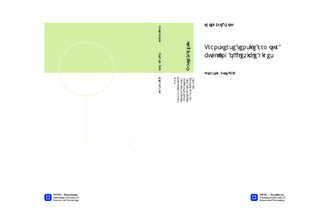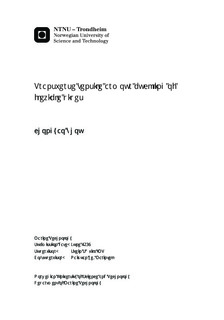| dc.description.abstract | During the installation and operation process, the empty flexible pipe will experience a largeend fitting load which is the compression load at the ends of the pipe. At the same time, the dynamicload from wave and current will force the pipe to bend cyclically which will cause thetransverse buckling within the tensile layers. The end of pipe will rotate due to the transversebuckling mechanism during each cycle, resulting in a serious end rotation to make the pipe collapse.This thesis will study transverse buckling behaviour under different loading conditionsand performthe sensitivity analysis to study the influence of the relevant characteristic parameters.This section will briefly summarize the main contents and conclusions in the thesis. INTRODUCTIONChapter 1 is the introduction of the master thesis, including the study motivation, previous literatureoverview about this topic, the main contributions of this thesis and the structure of therest thesis. LITERATURE STUDYChapter 2 and Chapter 3 are the literature study, focusing on the flexible pipe technology, failuremodes and design criteria. Chapter 2 includes an introduction to the flexible pipe applicationsin the offshore industry, flexible pipe structure and termination of riser. Chapter 3 is a briefintroduction of failure modes and design criteria. THEORY AND METHODChapter 4 is an introduction to the linear finite element methods and non-linear finite elementmethods and the relevant non-linear code used in FEM software, Bflex2010 andMarc. The theorybackground of the finite element model established in Bflex2010 and the analytical methodsfor stress and buckling analysis in tensile armour are also shown in this chapter. The physicalinterpretation of the lateral buckling failure mode is shown as well. MODEL ESTABLISHMENTChapter 5 is an introduction of the model establishment, including the simplified model(onetendon without friction) and the full model(all the layers including anti-buckling tape). Thedetermination of loading conditions, boundary conditions and relevant important parametersare also introduced. BUCKLING PERFORMANCE STUDY OF SIMPLIFIED MODELChapter 6 is the lateral buckling study of the simplified model, including the influence of layangle, start angle and imperfection. Three sensitivity studies for the time interval, axisymmetricinteraction and start procedure in Bflex2010 are also carried out.Lay angle will have a big influence on the buckling occurring positions during the processof loading, but it is hard to predict. However, the buckling load capacity will be increased dueto the decrease of lay angle, which is testified by the analytical solution and tests in Bflex2010.The start angle will have no influence on the buckling load capacity except the buckling occurringpositions. The imperfection will lead to a sudden axial force increase in the tendon whichis shown as a snap in the realistic physical issues. This phenomenon will be presented and explainedin the thesis.For the sensitivity study, the following conclusions can be obtained: 1) The length of timeinterval will decide the accuracy of the test in Bflex2010. The smaller time interval will capturethe buckling behavior at the beginning of the process. 2) The axisymmetric interaction and startprocedure will not have a significant influence on the test results. BUCKLING PERFORMANCE STUDY OF FULLMODELChapter 7 is the lateral buckling study of the full model, including the comparison with the simplifiedmodel under the same load conditions, the detail study of the lateral buckling of tendonsand the end rotation of riser caused by lateral buckling due to the cyclic bending.The results of full model are also close to the analytical solution and a little more conservativethan the simplified model. The end rotation behaviour due to transverse buckling is studiedby full model, which can simulate the failure modes in a right way and the results will be closeto the experimental results if the additional axial stiffness of pipes in experiments is provided.The sensitivity study is performed to study the effect of anti-buckling tape. The results showthat the anti-buckling tape has a large effect to prevent the transverse buckling and the lay angle direction of the anti-buckling tapewill also affect the transverse buckling behaviour and preventthe buckling process to a great extent. | nb_NO |

